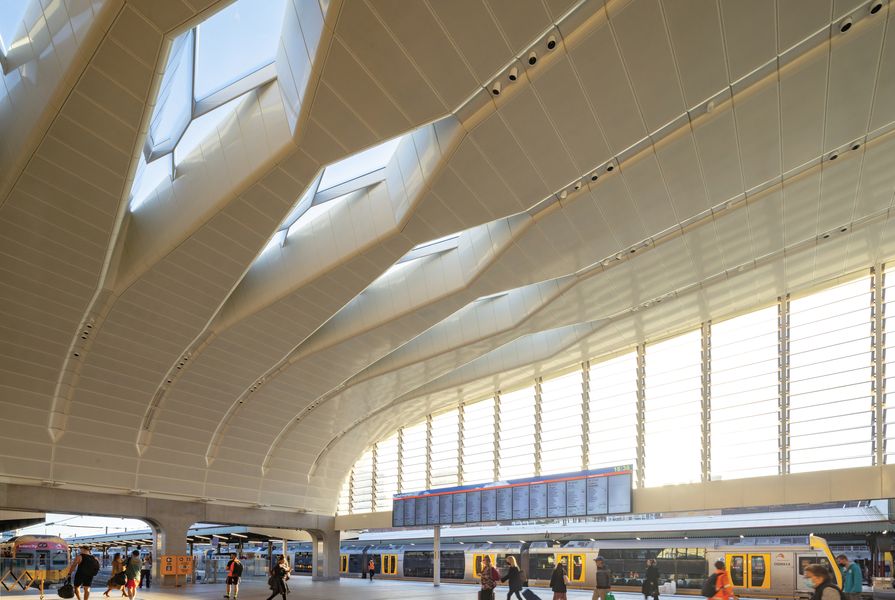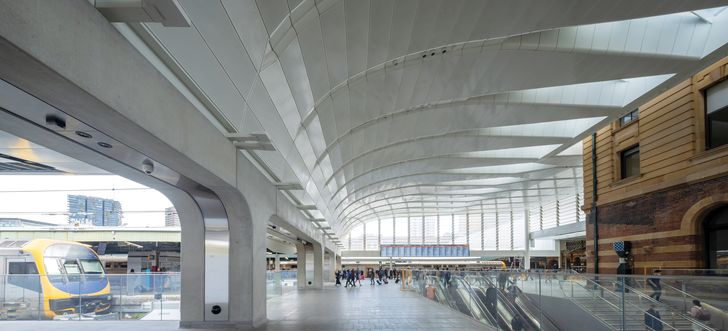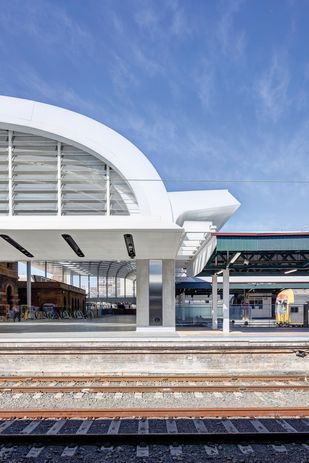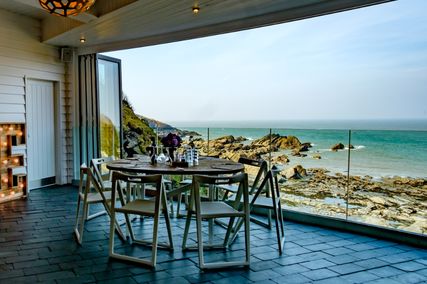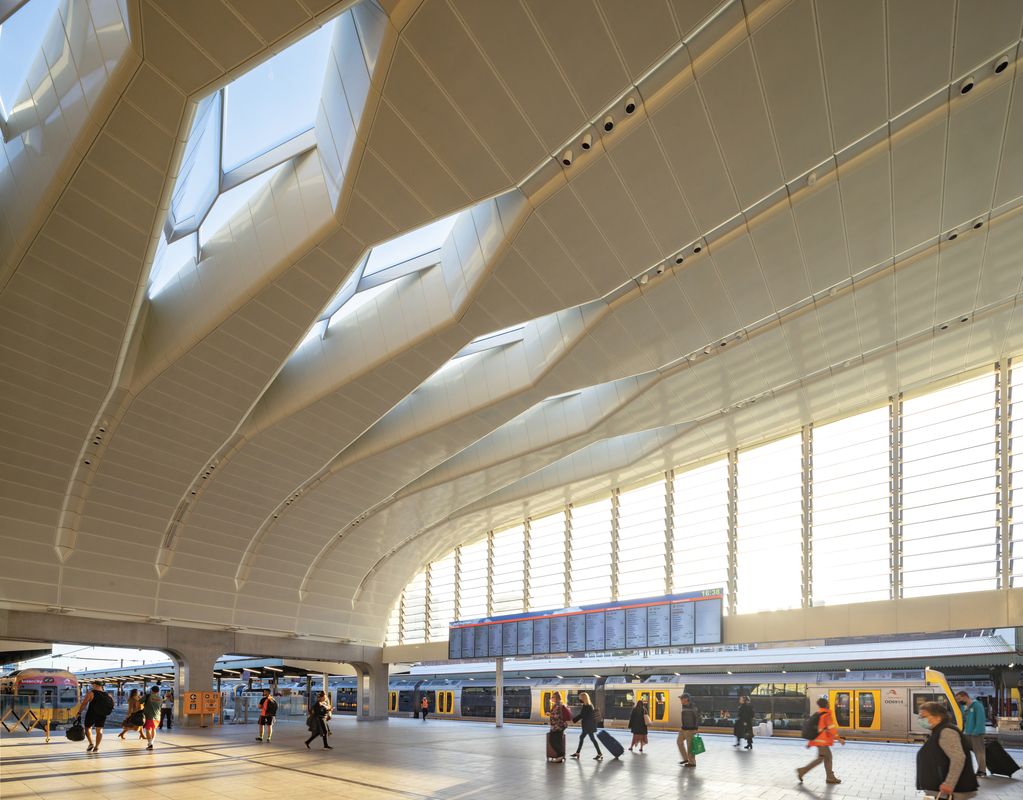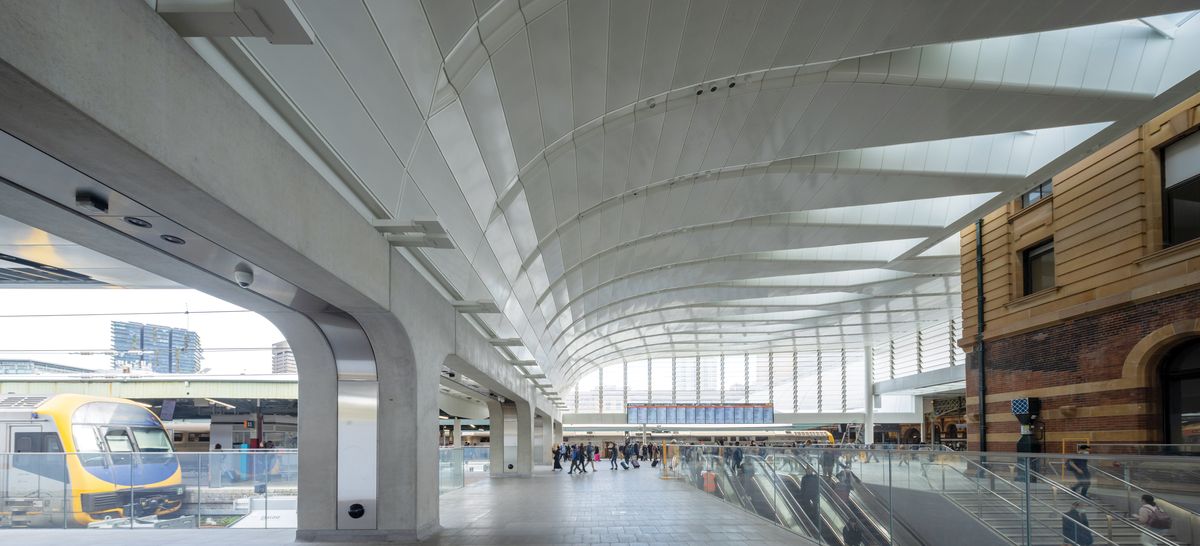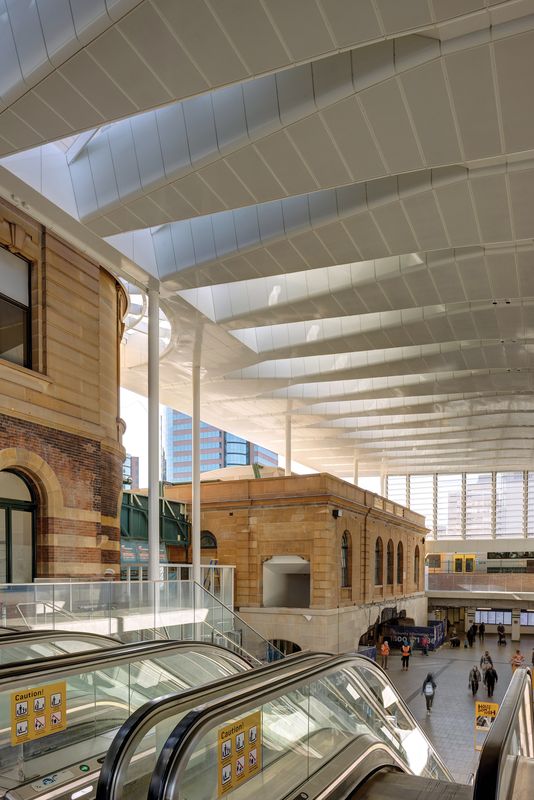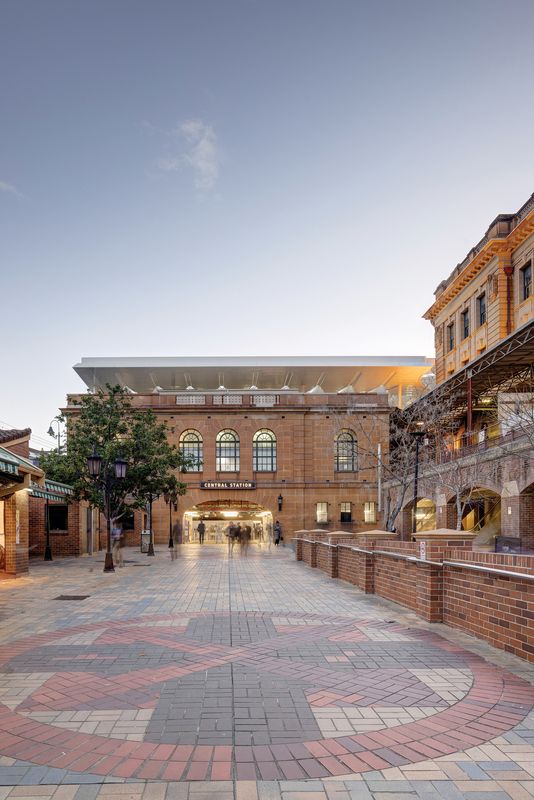After many years of inaction, railway infrastructure in the Sydney basin is undergoing its largest building boom since the creation of the City Circle line from 1926 to 1956. Sydney Metro is Australia’s biggest public transport project; by 2030, Sydney will have four metro lines, 46 new stations and a 113-kilometre standalone metro railway system. One part of this project is the Sydney Metro City and Southwest line – and one part of this involves tunnelling under Central Station, Australia’s busiest railway station, to insert two metro platforms.
This work has triggered the opportunity to upgrade the whole station with new entries, connections and circulation spaces; and to uplift the overall look and feel by making the facility more legible and integrated. One small part of this work is the Northern Concourse expansion, which is the subject of this review. It is not a small space, but in the context of the larger build, it seems that way. You could describe it as an iceberg project: what pokes out above ground is a tiny part of what lies underneath. During my site visit, the metro platforms were very much under construction, but the above-ground component – the Northern Concourse slotted behind the historic sandstone station – was open to the public. The first impression now is one of abundant fresh air and light, with clear sightlines and generous spaces for circulating or pausing that have already improved arrival and departure experiences for the thousands of commuters who use Central Station every day.
Visually striking from within and without the station, the new geometric roof volume fits the project’s grand civic scale.
Image: Brett Boardman
Before we delve into the new build, some historic context is useful. The original station, designed by government architects Walter Liberty Vernon and George McRae, was completed in stages from 1906 to 1921. When the City Circle line was built, the station expanded east so that suburban trains could continue past Central. It was at this stage that the site became imbalanced, losing the clear legibility of the terminus building and the organizing space of the Grand Concourse. The 1970s addition of the Eastern Suburbs railway line made the imbalance worse.
Since then, the station has suffered the piecemeal alterations and additions typical of large government assets, with a cacophony of platforms, tunnels, pedestrian entries, retail and offices added at will. Circulation spaces became compressed, impeding sightlines and erasing legibility. Each of these layers contributed to a bloated, clumsy result that needed an intervention to clear away the accretions of the past, and organize and unite the remaining components east of the original station – within something that could deliver the scale of the original Grand Concourse without emulating it. This is where the Northern Concourse comes in.
Led by Laing O’Rourke, an international engineering and construction company with a significant presence in Australia, Woods Bagot and UK-based John McAslan and Partners were one of three teams that competed for the right to design and construct the Northern Concourse. Often, the key to winning a competition is to challenge one of the primary tenets of the brief. In this case, the brief called for the new works to be subservient to the heritage-listed sandstone Central Electric building, tucking behind and under its parapet. Instead, the team proposed that the concourse roof vault over the existing building, framing it from the inside and capping it from without.
It was a simple but clever move, respecting the heritage fabric and expanding the scale of the covered space. The volume of the Northern Concourse would be comparable to the Grand Concourse, creating civic scale appropriate to the thousands of people who pass through it every day. The sectional drawing illustrating the half-vault move is immediately convincing, with a strong geometry that references the Grand Concourse without mimicking it. The ribs of the vault peel open to create V-shaped skylights that fill the space with natural light. The ceiling is clad with white powdercoated aluminium panels. Permanently open glass louvres terminate the vertical ends of the vault, providing fresh air and smoke exhaust.
In a departure from the competition brief, the new roof vaults over the heritage Central Electric building.
Image: Brett Boardman
However, strong geometries are inherently not very flexible. The adjacent east wing of the original terminus building is taller than the Central Electric building, and the roof and skylights must trim around it. Beyond this wing, the roof needs to reach further to the north and step down to close the gap with the Grand Concourse. The architects have worked hard to resolve these geometries, but there are some awkward junctions that muddy the simplicity of the roof as a single extruded shape sailing over the heritage fabric.
When I visited, many aspects were yet to be completed: a generous east–west link named Central Walk, located under the existing suburban platforms midway between the Northern and Southern concourses, will connect the metro platforms with a new eastern entry building and light rail on the Chalmers Street side. The metro walls will be clad in tessellated engineered sandstone panels that incorporate an abstract motif and reference the original sandstone buildings above.
Precast concrete beams were transported to the site to speed up construction and minimize transit interruptions.
Image: Brett Boardman
One of the fundamental considerations for the project team was how to maintain station operations during construction; this was accomplished by limiting the time each part of the station was occupied. The entire Northern Concourse roof was assembled just north of Newcastle, then broken down into truck-sized components, delivered to site and reassembled over the quieter Christmas period. It was like making a full-scale prototype, where design and assembly issues could be resolved before arriving on site. Precast concrete columns and beams were also used to speed up site works; they support the concourse roof springing point and act as gateway elements to the intercity platforms.
Unlike the underground eastern suburbs line built in the 1970s, which always felt disconnected from the main station, the new metro platforms will be fully integrated, sitting under the heart of the station on axis with the approach from Eddy Avenue. The entrance has been made more direct, with sightlines that look straight through to the concourse and the metro platforms beneath. Originally terminated by a retaining wall, this view has been excavated and opened up. Where the ground has been excavated, a sandstone skirt wraps the base of the building as though it has always been there.
Now that the works are nearly completed, it is easy to forget what was there before because so much of the new work feels intuitive. This speaks to the success of the project. By thoroughly analysing and understanding the site’s opportunities and constraints, the architects have successfully unravelled what was not working and unearthed the diagram waiting to be found.
Credits
- Project
- Sydney Metro Upgrade of Central Station
- Architect
- Woods Bagot
Australia
- Project Team
- Woods Bagot team: John Prentice, Andrew Tattersall, Meghan Nordeck, Domenic Alvaro, Neil Hill, Martin Fox, Larisa Mos, Hannah Thompson, Dinko Arar, Raflen Genovia, Andrea Ladisla, Jonathan Teng, Nathaniel Steward, Solomon Romion, Stephen Taskin, Zig Peshos, Derek Faure, Julian Heers, John Morris, John Norman, Nishanth Saha, Lucy Turnbull, Daniel Yeung, Yan Rean Zhuo, Ewan Chong, Apollo Michaelides, Wenxi Ren, Philip Tsui, Kye Tan, Mark Zhang, Glenda Yiu, Kaustav Gupta, Peter Wake, Rob Wright; -, John McAslan and Partners team: John McAslan, Fanos Panayides, Troy Uleman, Colin Bennie, Anna van Hees, Arun Agranat, Aubrey Zacharias, Calin Petrescu, Lizz Riley-Evans, Luca Alessi, Manal Salama, Mariela Oncina, Marina Savochkina, Mark Crabbe, Misbah Khaliq, Nik van Herpt, Rhys Roberts, Simon Markus, Stephen Oliver, Vivian Liu, Yuewei Zhang
- Architect
- John McAslan and Partners
NSW, Australia
- Consultants
-
Access and maintenance consultant
Karabiner Access
Access consultant Accessible Building Solutions
Acoustic consultant Wilkinson Murray (now RWDI)
Back-of-house architecture design AGJV (Aurecon/GHD joint venture)
Builder Laing O’Rourke
Building surveyor BCA Logic (now Jensen Hughes)
Customer-centred design and industrial design Büro North
Environmental consultant NGH Environmental
Facades Taylor Thomson Whitting (TTW)
Fire engineer Warringtonfire
Flooring technical advisor Techtile Consulting
Front-of-house lighting design Steensen Varming
Heritage OCP Architects
Human factors and pedestrian modelling AGJV (Aurecon/GHD joint venture)
Indigenous heritage Artefact
MEP engineer AGJV (Aurecon/GHD joint venture)
Project manager Laing O’Rourke
Public art Creative Road
Quantity surveyor Laing O’Rourke
Rail, structural and civil engineer AGJV (Aurecon/GHD joint venture)
Sustainability AGJV (Aurecon/GHD joint venture)
Urban planning Woods Bagot, John McAslan and Partners
Wayfinding Büro North
Wind engineering, glare and reflectivity Windtech
- Site Details
- Project Details
-
Status
Built
Category Public / cultural
Type Public / civic, Transport
Source
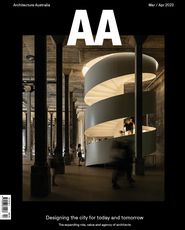
Project
Published online: 20 Apr 2023
Words:
Andrew Nimmo
Images:
Brett Boardman
Issue
Architecture Australia, March 2023

